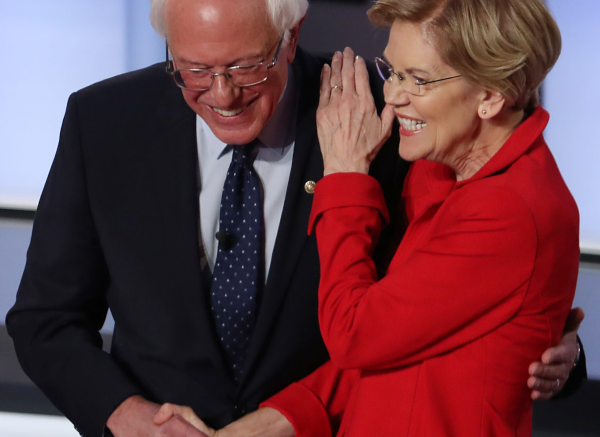This article appears in the current issue of Solidarity.
American politics has made a sharp turn to the left in recent years – a turn that few anticipated, but that underpins much of what is going on in the Democratic primary now underway.
The two leading progressive candidates, Bernie Sanders and Elizabeth Warren, together represent a clear majority of Democratic voters. The party’s “moderate” wing thought it had a winner in Joe Biden, but the implosion of his campaign has led to a search for viable alternatives to the two Democratic senators from New England. Mayor Pete Buttigieg is emerging as the hope of that wing of the party as all the other candidates struggle to show any support in recent polls.
Any of the Democratic candidates would be huge improvements over Trump, obviously. And of them all, Elizabeth Warren is far and away the most progressive – except for Bernie Sanders.
So where do they differ? Warren proudly calls herself a capitalist, and was a Republican party supporter until the mid-1990s. Sanders calls himself a democratic socialist, and has been active on the American left since the early 1960’s when he was a member of the Young People’s Socialist League. Unlike Warren, Sanders speaks the language of the socialist left. Speaking to trade unionists in Iowa recently, he said that “if there’s going to be class warfare in this country, it’s about time the working class won that war.”
That difference also expresses itself in policies, where Sanders is consistently somewhat to the left of Warren. This is even true with a proposal like Medicare for All, where the two candidates seem to be reading from the same page.
But the main difference between them is how they see social change happening in America. Warren has detailed plans to fix social problems one by one. Sanders sees a grassroots movement, and in particular a revitalised trade union movement, as central to turning his vision into reality.
Sanders says that if elected, he’ll play the role of “organiser-in-chief” and is counting on mass popular support to pass his radical program of change. Warren says nothing of the sort.
He models himself somewhat on President Franklin Roosevelt, whose New Deal reforms were made possible by the rise of a radicalised labour movement in the 1930s. And he grew up at a time of radical social change in 1960’s, underpinned by the growth of increasingly left-wing civil rights and student movements.
Sanders is especially focussed on strengthening America’s greatly weakened trade union movement. He has pledged to double the membership of unions during his first term in office. While other Democratic candidates have made similar pledges in the past – especially to reform labour law to allow unions to organise and grow – they have not followed through once elected. Sanders understands that there will be no real change in the country without massively stronger trade unions.
It would be best for American workers if Sanders is the Democratic nominee in 2020. But right now, he’s in a tough fight to win that nomination. In most polls, Warren is ahead of him. If she wins the nomination, Sanders has already pledged to support her (or any other Democrat running against Trump).
Not all Sanders’ supporters share his view. Three months ago, Democratic Socialists of America (DSA) voted at its national convention in Atlanta for a “Bernie or Bust” resolution – saying that if Sanders was not the party’s nominee in 2020, they would not officially support anyone, not even Elizabeth Warren. Others, socialists among them, disagree.
Whether Sanders is the nominee or Warren, the Democrats will likely embrace the most radical platform any American political party has proposed since the 1930s. But of those two candidates, it is Sanders who best understands what it takes to turn such a platform into reality.
